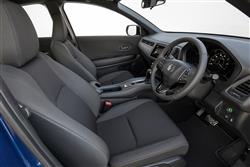How will you view?
This is a sample, and will stop after 30 seconds.
A MORE HONDA KIND OF SMALL SUV (some text hidden) SECTIONED_new_hondahr-v_2019
By Jonathan Crouch
Introductionword count: 135
Having given other brands the original idea for compact SUV motoring, Honda developed its own modern interpretation of what a car of this kind should be with the second generation HR-V model launched in 2015 and updated in early 2019 to create the car we're going to look at here. It was aimed at the premium end of the Nissan Juke and Renault Captur class, offering smart looks, impressive safety credentials and the choice of petrol or diesel power. Buyers also get a brilliantly practical interior thanks to so-called 'Magic Seat' ingenuity and a slightly larger body shape than is the norm in this sector. If you're shopping in this segment for a small SUV made in the 2019-2021 period and you're prepared to stretch your budget a little, we think you'd probably like one.
Modelsword count: 24
5dr compact SUV (1.5 VTEC petrol - 130PS / 1.5 VTEC petrol turbo - 182PS / 1.6 i-DTEC diesel 120PS (S, SE, EX, Sport])
Historyword count: 410
Honda's HR-V was designed to bring something a little different to the market for small, fashionable little SUVs. Like its crossover rivals from the Juke-genre, this is essentially a supermini-based model, but at its original launch in 2015, we appreciated the fact that its more versatile interior offered more the kind of space you'd expect to find in a medium-sized Qashqai-class SUV from the next class up. In early 2019, the HR-V was usefully updated - and that's the car we're going to look at here. First some background. Well done to you if you remember the very first generation HR-V, launched back in 1999 and probably the model that should have started the current seemingly insatiable craze for small SUV crossovers. Unfortunately for Honda, that car didn't have either the marketing, the peppy handling or the visual pizzazz that would characterise the segment-defining Nissan Juke at its launch eleven years later. That original HR-V - marketed as 'the Joy Machine' - was withdrawn from Honda's range in 2006 and, amazingly, not replaced for European markets. It was a wasted opportunity. Still, the brand subsequently learnt from it, with proof of that delivered just under a decade later when the original version of this second generation design made its first appearance. Subsequent sales were relatively modest, partly because initial versions of this MK2 model lacked the overtly fashionable looks of trendier segment rivals; partly because Honda price-positioned this car towards the top end of the small SUV sector; and partly because early production numbers were limited by the Mexican factory's priority to satisfy the American market. By the end of 2018 though, Honda was ready to get a little more serious about this growing segment, hence the need for a usefully revised version of this MK2 HR-V. Nothing too fundamental was changed here. The outside look got a little smarter and the interior became of slightly higher quality. More significant were the improvements in refinement and efficiency. And there was a fresh flagship variant too, the 'Sport' version, which featured a more powerful 182PS 1.5 VTEC TURBO petrol powerplant, joining the existing normally aspirated 1.5-litre petrol and 1.6-litre DTEC diesel units already offered in the range. All models featured a key HR-V selling point, a cleverly versatile 'Magic Seat' interior that makes every other car in the class from this period seem cramped and compromised. The MK2 HR-V sold until mid-2021, when it was replaced by an all-new hybrid model.
What You Getword count: 523
Honda wanted this facelifted version of the second generation HR-V to have more universal appeal than the rather bland-looking original, the idea being to reach a wider cross-section of buyers. If you like the idea of a small SUV from the 2019-2021 era, but find a Nissan Juke from this period too wilfully outlandish, a Peugeot 2008 rather bland and a Jeep Renegade rather ugly, then this, perhaps, could be your car. The so-called 'coupe-like SUV' looks are stylish enough to stand out, without making a statement likely to offend anyone. In its original form, there wasn't much wrong with this car's cabin that a few nicer materials, plastics and fabrics wouldn't have put right, so that's what Honda did with this revised design. Otherwise, it's all very much as before, which means you get a rather low-set driving position, plenty of cabin storage and a rather curious Seventies-style 'wide flow' air outlet, situated ahead of the front seat passenger. Most variants get a 7 -inch 'CONNECT' centre-dash infotainment touchscreen, complete with navigation, a decent DAB audio system and the option to download various apps. One of these, 'Aha', comes built in to the system, giving you access to thousands of stations of audio, spanning everything from music to news, podcasts and audio. In the rear, you'll find that the HR-V is one of the most spacious models in the compact Crossover class from this period. What really marks this HR-V apart from its contemporaries though, is the packaging brilliance of its so-called 'Magic Seat' system. It's something that's made possible by this Honda's centre-mounted fuel tank layout. This liberates the floor of the cabin and allows all kinds of interior permutations. Take the 'Magic Seat' 'Tall mode' where the front of the rear seat base rises up and can be locked in a vertical position to leave a cargo height of 1,240mm from floor to ceiling, allowing the object in question to be placed behind the front seats. It's ideal for tall, fragile items - maybe a small potted tree you've bought from the garden centre; or perhaps a bulky item of electrical equipment. The other two 'Magic Seat' settings relate to the more conventional cargo configurations. Raise the rear hatch and you'll note the wide cargo opening and low loading lip that pave the way towards a conveniently-shaped boot that's VDA-rated at 431-litres and is pretty spacious by small SUV standards. But let's say you need more room and want to push forward the 60:40 split-folding rear seats to, for example, store something like a bicycle. That's when you move into the 'Magic Seat' system's 'Utility Mode' and the first thing you notice with that is the ease of the folding process. With this HR-V, you've only to release a simple lever mechanism, push forward from the rear and watch as backrest and seat base retract together into the rear foot well in one quick, fluid motion. If you're not using the front passenger seat, there's the option to recline it as part of the final 'Magic Seat' 'Long mode'. With that done, items as long as 2,445mm can be accommodated.
To see the full road test text contact us on 0330 0020 227
Pictures (high res disabled)

.jpg)
|
.jpg)
|
.jpg)
| |||
.jpg)
|
.jpg)
|
.jpg)
| |||
.jpg)
|
.jpg)
|
.jpg)
| |||

|
Scoring (subset of scores)
Category: Crossover or SUV 4x4s
| Performance | |
| Handling | |
| Comfort | |
| Space | |
| Styling, Build, Value, Equipment, Depreciation, Handling, Insurance and Total scores are available with our full data feed. | |



